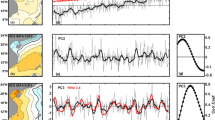Abstract
A strong warm event happens during spring 1997 to spring 1999 in the South China Sea. Its intensity and duration show that it is the strongest event on the record over the past decades. It also corresponds with the severe flood over the valley of the Yangtze River and a couple of marine environmental events. This note addressed the evolution process by using several data sets, such as sea surface temperature, height and wind stress in addition to subsurface temperature. The onset of the warm event almost teleconnects with the El Niño event in the tropical Pacific Ocean. Summer monsoon is stronger and winter monsoon is weaker in 1997 so that there are persistent westerly anomalies in the South China Sea. During the development phase, the warm advection caused by southerly anomalies is the major factor while the adjustment of the thermocline is not obvious. Subsequently, the southerly anomalies decay and even northerly anomalies appear in the summer of 1998 resulting from the weaker than normal summer monsoon in 1998 in the South China Sea. The thermocline develops deeper than normal, which causes the downwelling pattern and the start of the maintaining phase of the warm event. Temperature anomalies in the southern South China Sea begin to decay in the winter of 1998–1999 and this warm event ends in the May of 1999.
Similar content being viewed by others
References
Webster, P. J., Yang, S., Monsoon and ENSO: Selectively interactive systems, Q. J. R. Meteorol. Soc., 1992, 118: 877.
Qu, T., Mitsudera, H., Yamagata, T., The intrusion of the North Pacific waters into the South China Sea, J. Geophys. Res., 2000, 105: 6415.
Xie, Q., Yan, L. N., Hou, Y. J. et al., Long-term oscillations in sea surface temperatures in Nansa Islands and the warm pool and their coupling process, Oceanologia et Limnologia Sinica (in Chinese), 1999, 30(1): 88.
Wang, D. X., Zhou, F. X., Qin, Z. H., Study on air-sea interaction on the interannual timescale in the South China Sea, Acta Meteorologica Sinica (in Chinese), 1997, 11(1): 45.
Reynolds, R. W., Smith, T. M., Improved global sea surface temperature analyses using optimum interpolation, J. Climate, 1994, 7: 929.
Legier, D. M., Navon, I. M., O’Brien, J. J., Objective analysis of pseudo-stress over the Indian Ocean using a direct-minimization approach, Mon. Wea. Rev, 1989, 117: 709.
Kalnay, E., The NCEP/NCAR 40-year reanalysis project, Bull. Amer. Meteor. Soc., 1996, 77: 437.
White, W. B., Design of a global observing system for gyre-scale upper ocean temperature variability, Prog. Oceanogr., 1995, 36: 169.
Wu, G. X., Meng, W., Gearing between the Indo-monsoon circulation and the Pacific-Walker circulation and the ENSO, Part I: Data analyses, Chinese J. Atmos. Sci. (in Chinese), 1998, 22(4): 470.
Saji, N. H., Goswami, B. N., Vinayachandran, P. N. et al., Adipole mode in the tropical Indian Ocean, Nature, 1999, 401(6751): 360.
Su, J. L., Xu, J. P., Cai, S. Q. et al., Circulation and Eddies in the South China Sea, Onset and Evolution of the South China Sea Monsoon and Its Interaction with Oceans (eds. Ding Yihui & Li Chongyin), Beijing: China Meteorological Press, 1999, 66–72.
Wu, C. R., Shaw, P. T., Chao, S. Y., Seasonal and interannual variations in the velocity field of the South China Sea, Journal of Oceanography, 1999, 54: 361.
Wang Weiqiang, Wang Dongxiao, Shi Ping, Annual and interannual variabilities of dynamic fields in the South China Sea, J. Tropical Oceanograpgy (in Chinese), 2001, 20(1): 61.
Yin, K., Harrison, P. J., Chen, J. et al., Red tides during spring in Hong Kong: is El Niño responsible? Mar. Ecol. Prog. Ser., 1999, 187: 289.
Author information
Authors and Affiliations
Corresponding author
About this article
Cite this article
Wang, D., Xie, Q., Du, Y. et al. The 1997–1998 warm event in the South China Sea. Chin. Sci. Bull. 47, 1221–1227 (2002). https://doi.org/10.1007/BF02907614
Received:
Issue Date:
DOI: https://doi.org/10.1007/BF02907614




